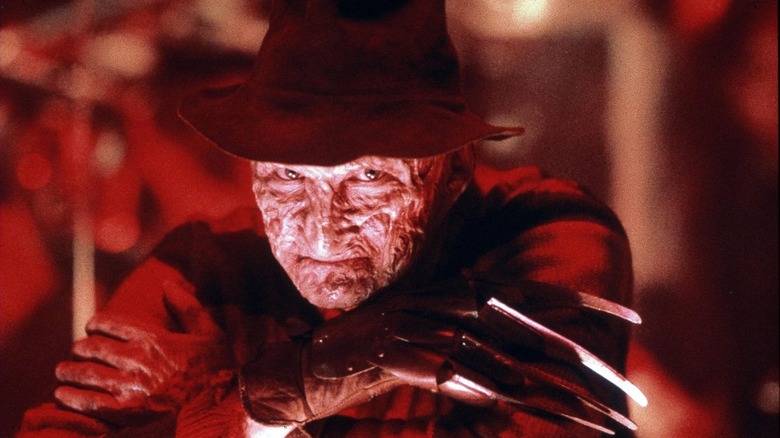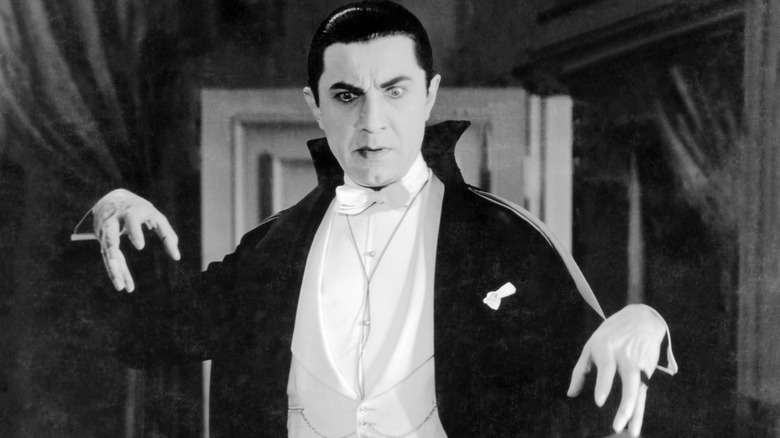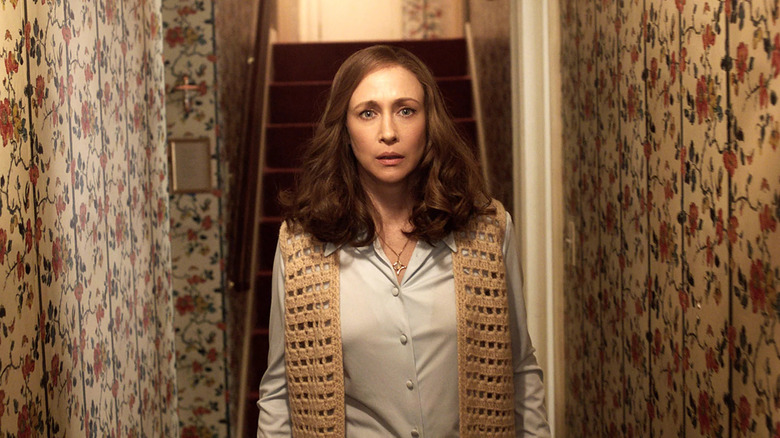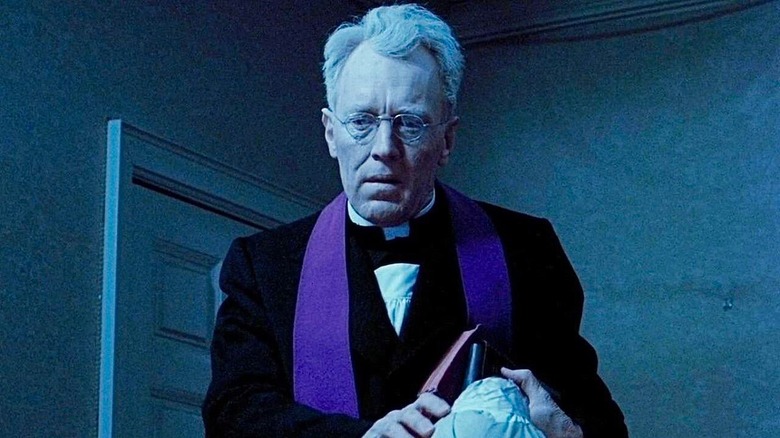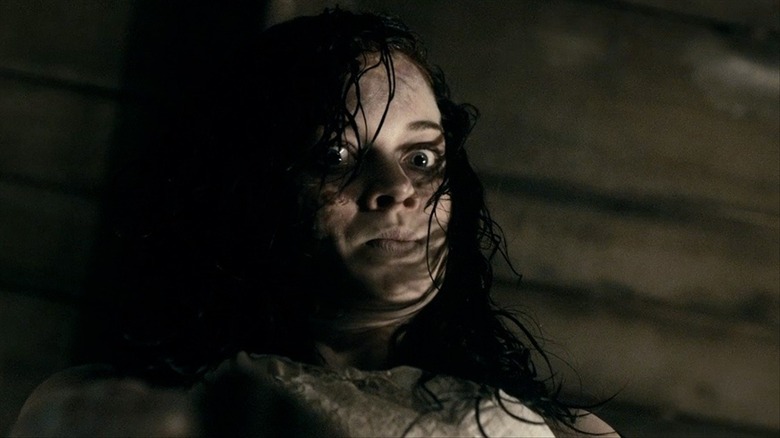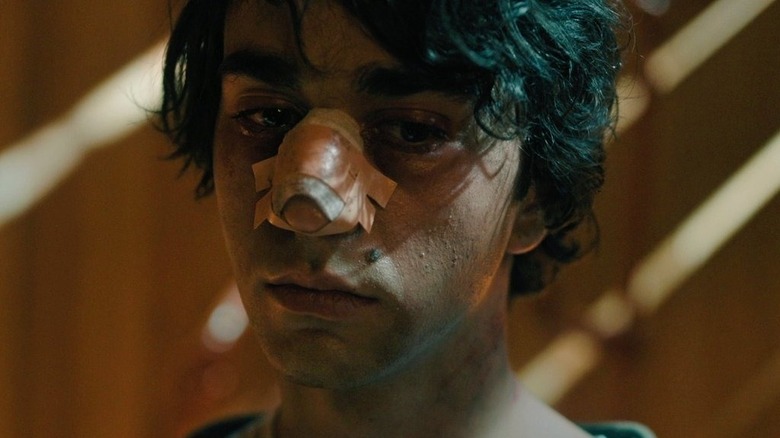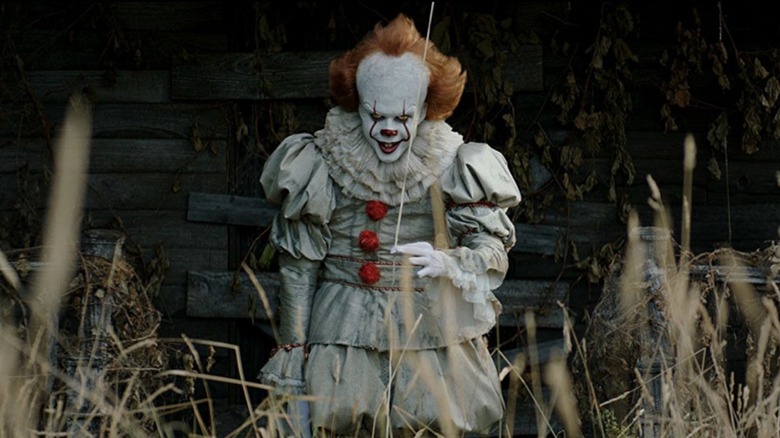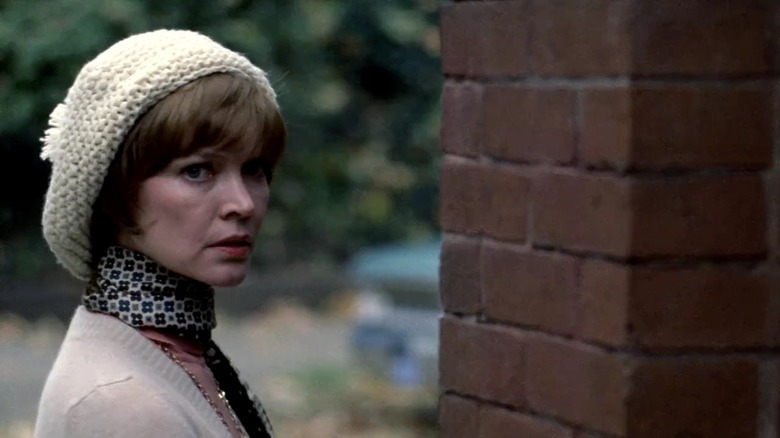Horror Roles That Changed Actors Forever
We often think about the life-changing impact horror has on us. Whether it was Regan MacNeil doing the spider walk in "The Exorcist" that made us terrified of stairs, "Jaws" effectively making us never want to set foot in the water again, or "Psycho" forcing us to develop questionable hygiene habits, horror movies leave a serious mark. But what about the actors who have to make those movies that scare us half to death? Sometimes, they can't let go of the strange things that happened on set, or they feel ... haunted. Some actors wind up "cursed" by horror movies, so to speak, in as much as they get pigeon-holed in their career. They can get physically hurt or suffer some serious trauma while making a movie, and in some cases even risk losing their careers altogether.
These 11 stories may not send chills down your spine, but they certainly changed the lives of the actors forever.
Robert Englund Will Always Be Freddy Krueger
Robert Englund is the horror icon, Freddy Krueger. Anyone can put on Jason Voorhees' hockey mask or bag head and become the quiet brute. Englund developed Krueger's personality over eight feature films, 44 episodes of the anthology show, "Freddy's Nightmares." The 2010 remake opted for a less empathic Freddy Krueger played by Jackie Earle Haley, yet something was missing — Robert Englund. He's one of few actors whose career mostly revolves around one legendary character, which, given that Englund is a tremendously hard-working actor, his laundry list of credits often goes unmentioned. How can we forget Englund's work as Mayor Buckman in "2001 Maniacs" or Buck in "Eaten Alive," for example, both of which play to Englund's sadistic sense of humor?
Englund's IMDb totals 168 credits as of January 2022, but how many can you recall that aren't Freddy Krueger? Whenever Englund appears in another indie horror flick as a professor, doctor, or elder with answers, he's still "that guy who played Freddy Krueger" to horror fans. Many forget Englund is a classically trained actor who starred in other projects like 1989's "Phantom of the Opera" or appeared on popular television shows like "Charlie's Angels."
Englund's range is vastly more diverse than his reputation suggests, thanks to Freddy Krueger's influence on horror fandom and pop culture. How many classical adaptations might Englund have explored had Freddy's publicity tour not taken precedence? Commercials, TV spots, Japanese variety shows — Freddy fever is incurable. There's no doubt that Englund's influence as a horror icon makes for an illustrious and well-deserved career. But one can't help but wonder about the performances we lost to Freddy's grip on the actor.
Bela Lugosi Couldn't Escape Count Dracula
When you think of movie vampires, you almost certainly think of Bela Lugosi. The icy glare, that charismatic screen presence, the now-iconic accent; Lugosi's portrayal cemented the popular silver screen image of a vampire in a way that's been tied to him since 1931's "Dracula." Being so strongly associated with that star-making role proved both a blessing and a curse as Lugosi found himself immediately typecast following the film's runaway success. He was unable to escape being repeatedly pigeonholed into similar horror roles in films like "The Raven" and "White Zombie." Adding insult to injury, Lugosi was repeatedly cast alongside fellow horror icon Boris Karloff and frequently received second billing in a series of Universal and RKO pictures.
When horror's popularity started to decline in the '30s, Lugosi's typecasted history put his career in a downward spiral and had a detrimental effect on his well-being. He suffered from increasingly severe chronic sciatica, for which doctors prescribed opiates like morphine. His drug dependence worsened in tandem with his career's decline, and in 1955 he voluntarily entered a state hospital for treatment. Released later that year, he spent the rest of his career working on a series of B-movies (often for the infamous Ed Wood, Jr.) before dying of a heart attack in 1956.
Lugosi was so intimately tied to the legacy of "Dracula" that he was famously buried in the long black cape he wore in the role, following his own wishes. It's a sad twist of fate that his incredible success in the role of Dracula ultimately contributed to a life of professional hardship and poverty that eclipsed other notable accomplishments, such as opposing rising European fascism and co-founding the Screen Actor's Guild.
His legacy, like the character he was so tragically unable to shake, nevertheless remains immortal.
Shelley Duvall Was Tormented While Making The Shining
Stanley Kubrick's 1980 horror film "The Shining," based on the book by Stephen King, has become a major part of the horror movie canon. The gorgeous, atmospheric film follows the Torrance family working as the winter caretakers for the Overlook Hotel. Unfortunately, father Jack (Jack Nicholson) starts losing his mind and talking to the hotel's ghostly residents and eventually tries to murder his wife, Wendy (Shelley Duvall), and son, Danny (Daniel Lloyd).
Kubrick was notoriously hard on Duvall, forcing her through a different kind of shoot than the rest of the cast. He tortured her to enhance her performance, overlooking that she was a real person with real feelings. He forced all of his actors to shoot their scenes a ridiculous number of times, but putting Duvall through 127 takes of crying and swinging a bat at her attacker is cruelty. Her hair began falling out, she woke up having crying fits, and she ended up having lasting trauma from the ordeal.
"The Shining" took 56 weeks to film. That means that, for over a year, Duvall put herself through the rigorous hell that Kubrick had devised for her. They filmed six days a week, for up to 16 hours a day, which is enough to make anyone miserable without being treated so poorly. Years later, she would tell The Hollywood Reporter that she doesn't know how she did it:
"[...] After a while, your body rebels. It says: 'Stop doing this to me. I don't want to cry every day."
Kubrick's treatment of Duvall was abuse, and no amount of prestige is ever going to wash that away. Actors shouldn't be traumatized for a performance, no matter how beloved or "talented" the person doing the traumatizing may be.
Vera Farmiga Felt Haunted After The Conjuring
Vera Farmiga is known for her turn as Christian demon hunter Lorraine Warren in the "Conjuring" franchise. After taking on the role, she claims she found herself plagued by unexplainable and creepy occurrences in her personal life.
The "Conjuring" actress, who stars alongside Patrick Wilson, alleged that she opened herself up to the spiritual world during her preparation for the first film. As a result, all sorts of strange things started happening. Rogue claw marks started appearing around her home, including on rolls of toilet paper and on her computer screen, and the day after she finished filming the first movie, she allegedly found three claw marks on her thigh. On multiple occasions, while shooting the first "Conjuring movie, she claimed she was woken up between the hours of 3:00 and 4:00 a.m., also known as "the devil's hour" or "the witching hour," considered the time of night when ghosts and other paranormal entities have a greater chance of appearing. These are just a few of the bizarre encounters has experienced since starting to play Lorraine Warren.
It's certainly possible that Farmiga was experiencing some bizarre, supernatural happenings. Considering the presumably fraudulent nature of Lorraine and Ed Warren's real-life paranormal investigations, it seems as though whatever entities were communicating with Farmiga likely had nothing to do with the true stories these movies were based on. That said, there's no denying something spooky was happening, and it left a lasting impression.
Max Von Sydow's Career Suffered After The Exorcist
For "The Exorcist," of course, Linda Blair had to wear tons of prosthetics and makeup for her truly horrifying closeups. But, believe it or not, Max von Sydow had to sit in the chair longer than Regan herself to get that perfect old-age look. It took roughly three and a half hours in the makeup chair to transform the then-44-year-old von Sydow into the 74-year-old Father Merrin. Emoting through the prosthetics was a chore, forcing the often understated von Sydow to over emote in order for his facial expressions to register properly. However, none of this stood in the way of him delivering an incredible performance that garnered him his second and final Golden Globe nomination.
Unfortunately, his Hollywood career hit a roadblock as a result. The makeup, it seems, was so good that many people in the industry actually believed the Swedish actor was in his 70s. U.S. casting directors were already reluctant to hire him because of his gravitas and grand screen presence, so this certainly didn't help matters. His already illustrious career in Europe did fine following the William Peter Blatty adaptation, but he wouldn't star in another American film until "The Ultimate Warrior" in 1975. He reprised his role as the old priest in "The Exorcist II: The Heretic" in 1976, then Emperor Ming in "Flash Gordon" in 1980, and Bond nemesis Blofeld in "Never Say Never Again" in 1986, but his Hollywood career took a while to recover.
Jane Levy Was Traumatized By Evil Dead
Actress Jane Levy delivers an all-timer performance as Mia in Fede Álvarez's remake-slash-sequel "Evil Dead," but the production process seems to have taken its toll. The sensationally violent horror film put Levy through the wringer with horrible weather conditions, sticky blood baths, and demands that pushed her to her brink. Levy went on to work with Álvarez again in "Don't Breathe," but didn't return for the sequel. Her comments about not participating in "Don't Breathe 2" should speak volumes about her experiences working on "Evil Dead" and beyond: "Maybe we should be asking why these films are made in such a way that their directors are averse to having committed actors participate?" One might argue it's for the sake of authenticity, but evaluating the cost of such authenticity is also worth discussing.
If you own "Evil Dead" on DVD or Blu-ray, there's a featurette that follows Levy through a particularly strenuous production day. You can see the hard work that led to such an outstanding performance, but the pain, exhaustion, and exasperation are apparent, as well. She's shown shivering between takes, soaked in fake blood raining from hoses, only briefly wrapped in warmer outerwear. Even worse, there's a scene where Levy's character, Mia, is buried alive.
"I had a plastic bag tied around my head with an oxygen tube behind my ear, laid in a ditch," Levy said. Once cameras stopped rolling, she would reportedly lose air and need to dig herself out of the ground. "No matter what anyone says, you never know what it feels like to have a huge tube that's like an inch-and-a-half diameter stuck down your throat so you can projectile vomit on someone's face," Levy recalls about a particularly gnarly "blood kiss" between her and castmate Jessica Lucas that caused a bloody nose at one point. By the end of filming, in Levy's own words, she had "nothing left."
Making Hereditary Was Hard on Alex Wolf and Milly Shapiro
In 2018, audiences were traumatized by Ari Aster's haunting family drama and psychological horror movie, "Hereditary." The film cleverly relies on the realistic horrors of uncomfortable family dynamics, trauma, and grief, which are augmented by the presence of a sinister supernatural entity. It also breaks the common cinematic trope of keeping children just out of harm's way in a particularly grotesque fashion with the shocking decapitation of a 13-year-old girl — including a close-up of her decomposing, insect-infested head.
As it turns out, merely viewing such deeply disturbing subject matter isn't nearly as damaging as making it. Alex Wolff and Milly Shapiro, the then-teenage actors who played Peter and Charlie, have opened up about the lingering negative impact of starring in one of the century's most horrifying films.
Shapiro, who was born with the genetic condition cleidocranial dysplasia (CCD), revealed in a TikTok video that she dealt with emotional damage as a result of the many cruel comments about her physical appearance in the movie. In it, she states how she was intentionally made to look her "worst" for the role, while the caption reads "I just remember when the trailer came out and one of the top three comments was about how ugly I looked hahahahhahahajahaahjzjsja live laugh love."
As for Wolff, the young actor has said that he also struggled psychologically and emotionally due to the demanding nature of the filming process. This included long periods of isolation in his hotel room akin to "The Shining," accidentally injuring himself and drawing real blood during the shocking face-slamming scene, and the frustrating method-acting that resulted in the realistic strained sibling dynamic between him and his younger costar. Their experiences certainly highlight the hefty price actors sometimes pay to help bring the movies we love to life.
Bill Skarsgård Never Got Over Pennywise
After Tim Curry, Swedish actor Bill Skarsgård is the second person to portray Pennywise the dancing clown — an ancient, trans-dimensional evil entity that preys upon the children of Derry, Maine, every 27 years. The monster was born in the pages of Stephen King's horror novel "It," and Skarsgård terrifically captured his essence in the 2017 silver screen adaptation and its subsequent sequel.
Pennywise has frightened several generations since the 1990 miniseries aired, but Skarsgård's performance raised the frightening bar. He worked on recreating Pennywise's menacing grin made famous by Curry and even added his own touch to the character: because the actor has a lazy eye, he can move his eyes independently, achieving the wall-eyed effect that many fans initially believed was CGI. In the process of connecting with Pennywise, Skarsgård felt isolated from his co-stars, who were afraid of being around the actor when he was in costume.
It also wouldn't be an exaggeration to say that the role changed him forever. Playing a child-killing monster is a task on its own, but having said child-killing monster haunting your dreams is something else entirely. The actor spent a lot of time with the character, and likened the process to a "destructive relationship." He was relieved when he finally put away the intimidating costume, but that didn't stop the fictional clown from invading his dreams.
In an interview with Entertainment Weekly, Skarsgård revealed that even though he was done working on the movie, Pennywise wasn't done with him yet; the terrifying dancing clown haunted his dreams. Sometimes, he even dreamed about himself as Pennywise in circumstances he "didn't appreciate." Now that's a nightmare I wouldn't want to have.
The Blair Witch and Cannibal Holocaust Casts Had a Lot in Common
"The Blair Witch Project" and "Cannibal Holocaust" are two horror films that, at face value, don't have very much in common other than their shared genres. However, they do share an interesting and unfortunate aspect of their respective marketing campaigns: they each claimed that their leading cast members were actually dead.
With "Cannibal Holocaust," Ruggero Deodato was put on trial for the murder of his principal cast. He had the actors sign contracts saying they wouldn't go out in public for a full year after the film's release to help sell the idea that they'd been murdered. They had to make an appearance in court to prove that they were, in fact, still alive. "The Blair Witch Project" adopted a similar campaign with its release, and it proved very effective. Due to the complete lack of internet when "Cannibal Holocaust" was released and its limited reach when "Blair Witch" came out in 1999, most folks believed it was true.
This was difficult for both casts, as they weren't exactly able to capitalize on the success of their respective projects because, well, they were allegedly dead. "It was very hard as a young actress where you did something where you were really proud of your work and you feel like you did a really good job, and then you're kind of in this really stuck situation where you're an overnight success, but you're dead," Heather Donahue, the lead actress of "The Blair Witch Project," told Paper Magazine in 2016. "It even said on my IMDb page that I was dead. It said Heather Donahue: Deceased."
There's no denying the influence of both films. But the decision to stand firm on the falsehood of these alleged deaths wound up ruining several careers. Though they will always be remembered as a part of something great, their work in the industry was never the same.
Making Possession Took a Toll on Isabelle Adjani
Andrzej Zulawski's "Possession" is a horrifying, brutal story about the end of a relationship. Long before "Midsommar" turned a breakup into a bloody nightmare, "Possession" dug into the delirium of a couple falling apart. Isabelle Adjani and Sam Neill star as Anna and Mark, a couple dealing with infidelity and a possible demonic possession. The movie is intense and occasionally histrionic, but Neill and Adjani each give it their all.
One infamous sequence shows Anna going through a miscarriage on a subway platform. She throws herself into walls and the floor, contorting her body and writhing in agony. Filming "Possession" was allegedly as painful as that very scene, and Adjani has spoken about the lingering trauma of the shoot for some time since its release. In an interview with The Playlist in 2016, she opened up about her experience, saying:
"It was quite an amazing film to do, but I got bruised, inside out. It was exciting to do. It was no bones broken, but it was like, 'How or why did I do that?' I don't think any other actress ever did two films with him."
In an interview with Film Comment, Zulawski said that actors must "pay a heavy price." Adjani ended up agreeing, telling Zulawski that she felt violated by the final cut of the film: "Your camera had no right to look there where it had insinuated itself."
Adjani has said that she required years of therapy after completing the role. Even Neill had a hard time with the production, telling Far Out Magazine in 2021 that he "just escaped that film with [his] sanity barely intact." "Possession" had a troubled release and has become an underground legend among the video nasty crowd, which is a shame because it keeps Adjani's incredible and soul-searing performance from getting the attention it deserves.
Linda Blair and Ellen Burstyn Were Severely Injured While Filming The Exorcist
"The Exorcist" is one of the most terrifying movies of all time for a reason. William Friedkin took what could have been a hoaky concept and imbued it with a haunting level of realism. Unfortunately, it came at a price.
Not unlike Kubrik's drive to elicit realism from Shelly Duvall, who he essentially tortured throughout the filming of "The Shining," Friedkin was dead set on things looking real in his film. That resulted in Ellen Burstyn sustaining a severe back injury that left her using crutches for the duration of the shoot. She was rigged up to a wired system that would pull her backward after Regan (Linda Blair) slapped her across the face, sending her flying across the room. When she voiced concerns that she was being pulled too hard, Friedkin told the rig tech to take it easy. Then, while Burstyn's back was turned, he told him to "really give it to her this time." It had a lasting effect on her, compounded by the fact that Friedkin has not only never apologized, but still denies she was actually hurt.
Unfortunately, something similar happened to Linda Blair.
In one scene, Regan famously thrashes backward and forward on her bed, before her throat bulges out and she screams obscenities at the doctors who just entered her room. To shoot the scene, Blair was laced into a rig that would whip her back and forth to create the unnatural movement. According to Blair in her "Cursed Films" interview on Shudder, "in this particular case, the lacing came loose. I am having my back pounded. I mean, I'm crying, I'm screaming ... they think I'm actin' up a storm." She fractured her lower spine and wasn't sent to the hospital. As with Burstyn's scene, Blair's injury is the footage that made it into the final cut of the film. Her back has never been the same.

